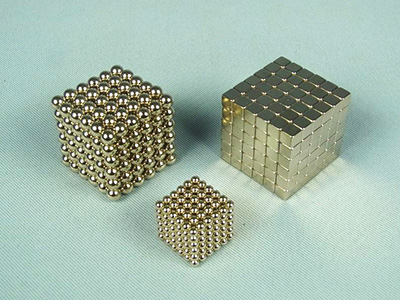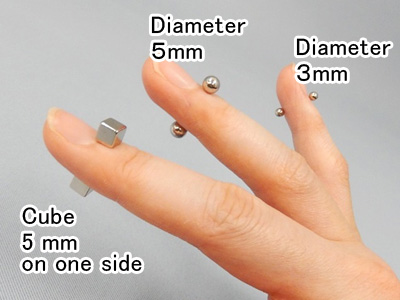Accidental ingestion of high powered magnetic balls - infant's digestive tract got holes, and the magnetic balls were removed by laparotomy
In January 2018, two reports of accidental ingestion of magnetic balls by infants were received in a row by the accident information mailbox from doctors (hereinafter called "Doctor Mailbox")1 and the Medical Facilities Network2. The infants accidentally ingested some magnetic balls, which perforated their gastrointestinal tracts and were removed by laparotomy. Both of the two infants swallowed two or more powerful magnetic balls labeled as neodymium magnets. These magnetic balls attracted one another through intestinal walls and remained there, and then perforated the gastrointestinal tract. These magnetic balls were removed by open abdominal surgery.
The Medical Facilities Network received 124 reports of actual or possible swallowing of magnets such as magnetic balls by children, which were registered from December 2010 through the end of March 2018.3 In addition, dozens of gastrointestinal injuries from magnet ingestion were reported by medical papers. Several Japanese organizations alerted people to danger from accidental ingestion of magnets (or ingestion of magnets and metals) in the past. Even after that, the above two accidents occurred in Japan.
Therefore, NCAC tested and surveyed magnetic balls in the market to issue an alert again on danger from swallowing two or more magnets such as magnetic balls.
- 1 The accident information mailbox from doctors (nickname "Doctor Mailbox") was launched on NCAC's website in August 2014 to promptly get accident information by directly receiving reports from doctors on injuries caused by using products or services and to utilize such information to prevent the occurrence and spread of similar incidents.
- 2 The Medical Facilities Network is a joint project by the Consumer Affairs Agency and NCAC which started operating from Dec. 2010. The network collects accident reports on people receiving treatment at medical facilities after suffering life-threatening or bodily injuries in their daily lives.
- 3 The above number was specially counted for this article.
Photo 1. Powerful magnetic balls

Photo 2. Magnetic force is so strong and two magnetic balls attract to one another through a finger.

Two magnetic balls of diameter 3 mm are on a pinky finger. Two magnetic balls of diameter 5 mm are on a medicinal finger. Two magnetic balls of cube 5 mm on a side are on a middle finger.
Accident cases reported to NCAC
Regarding the above two cases received by the Doctor Mailbox and the Medical Facilities Network in January 2018, NCAC investigated the background by hearing details from victims' parents and by checking actual products, in cooperation with doctors and medical facilities concerned.
- [Case1]
- Two kinds of magnetic balls were purchased via the Internet and were given to a boy for his Christmas present. The boy swallowed 5 magnetic balls, which his parent noticed. He was taken to a hospital. The X-ray showed that a string of 5 magnetic balls was inside his gastrointestinal tract. He needed to receive a follow up examination from a doctor. On the next day, the magnets remained in the same position. At a referred hospital, the boy underwent an endoscopic examination, but magnetic balls were not found in his stomach. The boy again needed to receive a follow up examination. Magnetic balls still did not move on the following day and the boy underwent surgery. Two magnetic balls perforated the stomach wall and three magnetic balls perforated the jejunum wall. The magnetic balls were removed and the perforated portions of the jejunum were sutured.
- (incident in December 2017; boy aged three years)
- [Case2]
- A girl saw that her infant friend was playing with magnetic balls and she wanted them. Therefore, her parent bought magnetic balls for the girl four months before. Seeing that the girl put some magnetic balls in her mouth at a later date, her parent kept magnetic balls out of reach of her. The girl repeatedly vomited, so the parent took her to a hospital. She was suspected to have gastroenteritis, and was prescribed a medicine. On the next day, she still vomited. After receiving a referral form, she was taken to another hospital. The X-ray showed some foreign objects in her bowel, and later the girl underwent open abdominal surgery. It was found that magnetic balls in three different positions attracted to one another and gathered the small bowel, which caused compression necrosis and the small bowel was perforated by the magnetic balls. Totally 37 magnetic balls of diameter 3 mm were removed by laparotomy.
- (incident in January 2018; girl aged one year and nine months)
Survey of representation on 32 sales websites
Magnetic balls are mostly sold via online shops. Therefore, NCAC chose and surveyed 32 sales websites in total, by reference to websites selling the magnetic balls related to the accidents as well as those ranked high in the search results of major online shopping malls4, and shapes and sizes of the products concerned.
- 4 Internet search as of March 6, 2018
- Most of the websites included representation which was reminiscent of toys.
- Thirty out of the 32 websites did not include caution messages about accidental ingestion by children.
Test results
Among the magnetic balls sold on the chosen websites, NCAC tested 7 brands, sizes and shapes of which are similar to those swallowed by the victims.
- Each of the magnetic balls was small enough for a child to swallow two or more together.
- When two magnetic balls were placed closer, they attracted to one another more strongly than ferrite magnets (reference products), even when the distance between the two was longer. In case of larger magnetic balls or in case of a string of several magnetic balls, they attracted to one another even when the distance was longer. If such magnetic balls are swallowed, they are considered to be more prone to attract to one another through intestinal walls.
- A larger force was required to separate magnetic balls compared to ferrite magnets. A magnetic force becomes larger when the size is larger or when several magnetic balls stick together. It is considered such magnetic balls are more prone to remain in the same position, attracting to one another through intestinal walls.
- The magnetic flux index of the each brand was larger than the value specified by the Japanese Safety Toy Standard.
- Packages did not bear manufacturers' names or caution messages about accidental ingestion. There was no instruction manual.
Advice for consumers
- It is very dangerous if two or more powerful magnetic balls are swallowed. Don't give magnetic balls to children.
- If someone may have accidentally ingested magnetic balls, take him / her to a hospital.
Requests to businesses
- There were some serious accidents where children swallowed two or more powerful magnetic balls, which were removed by laparotomy. NCAC requests businesses not to sell magnetic balls as children's toys and to clearly indicate the target age group and caution messages on packages and sales websites.
Request for cooperation to companies running online shopping malls
- There were some serious accidents where children swallowed two or more powerful magnetic balls, which were removed by laparotomy. NCAC requests for cooperation to companies running online shopping malls to properly guide online sellers and manage websites in order to ensure that magnetic balls are not sold as children's toys.
Request to the government
- Regarding products which have above a certain level of magnetic force and are small enough for a child to swallow and may be sold as children's toys, NCAC requests the government to keep consumers informed of risks from accidental ingestion, to guide businesses to prevent similar accidents, and to collect accident information to consider further preventive measures.
